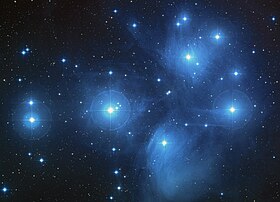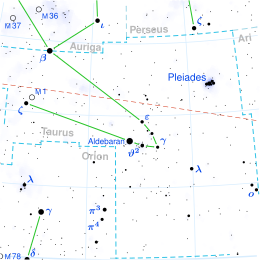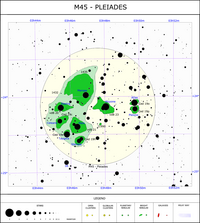A project is the inclusion of the proof to the fact and as arithmetic is in division of the sky to the land of a mountain it is a man to the human that makes being in the nerve enough to court the pyramids of this Earth to the monuments of unknown to what has been readily read in word worldwide and taken in literal to the conjecture. This engagement of what is difficult is at what will prove itself by whom is at the science of the sky to no longer being able to deny the science of belief in religion.
The Pleiades (),[7][8] also known as The Seven Sisters, Messier 45 and other names by different cultures, is an asterism and an open star cluster containing middle-aged, hot B-type stars in the north-west of the constellation Taurus. At a distance of about 444 light years, it is among the nearest star clusters to Earth. It is the nearest Messier object to Earth, and is the most obvious cluster to the naked eye in the night sky. It is also observed to house the reflection nebula NGC 1432, an HII region.[9]
The cluster is dominated by hot blue luminous stars that have formed within the last 100 million years. Reflection nebulae around the brightest stars were once thought to be left over material from their formation, but are now considered likely to be an unrelated dust cloud in the interstellar medium through which the stars are currently passing.[10] This dust cloud is estimated to be moving at a speed of approximately 18 km/s relative to the stars in the cluster.[11]
Computer simulations have shown that the Pleiades were probably formed from a compact configuration that resembled the Orion Nebula.[12] Astronomers estimate that the cluster will survive for about another 250 million years, after which it will disperse due to gravitational interactions with its galactic neighborhood.[13]
Together with the open star cluster of the Hyades, the Pleiades form the Golden Gate of the Ecliptic.
Origin of name[edit]
The name of the Pleiades comes from Ancient Greek: Πλειάδες.[14] It probably derives from plein ("to sail") because of the cluster's importance in delimiting the sailing season in the Mediterranean Sea: "the season of navigation began with their heliacal rising".[15] However, in mythology the name was used for the Pleiades, seven divine sisters, the name supposedly deriving from that of their mother Pleione and effectively meaning "daughters of Pleione". In reality, the name of the star cluster almost certainly came first, and Pleione was invented to explain it.[16]
Folklore and mythology[edit]

The
Nebra sky disk, dated circa 1600 BC. The cluster of dots in the upper right portion of the disk is believed to be the Pleiades.

1 dollar commemorative silver coin issued in 2020 by the
Royal Australian Mint. On the reverse, the Seven Sisters (Pleiades) are represented, according to an ancient story of Australian Indigenous tradition.
[17]
An image of the Pleiades nebula from earth taken with an amateur telescope from the Israeli
Negev desertThe Pleiades are a prominent sight in winter in the Northern Hemisphere, and are easily visible from mid-Southern latitudes. They have been known since antiquity to cultures all around the world,[18] including the Celts (Welsh: Tŵr Tewdws, Irish: Streoillín), Hawaiians (who call them Makaliʻi[19]), Māori (who call them Matariki), Indigenous Australians (from several traditions), the Achaemenid Empire, whence in Farsi (who called them پروین Parvīn or پروی Parvī),[20] the Arabs (who call them الثريا al-Thurayya[21]), the Chinese (who called them 昴 mǎo), the Quechua (who call them Qullqa or the storehouse), the Japanese (who call them 昴 / スバル Subaru), the Maya, the Aztec, the Sioux, the Kiowa,[22][23] and the Cherokee. In Hinduism, the Pleiades are known as Kṛttikā and are scripturally associated with the war-god Kartikeya but the Hindus celebrate the first day (new moon) of the month of Kartik as Diwali, a festival of abundance and lamps. They are also mentioned three times in the Bible.[24][25]
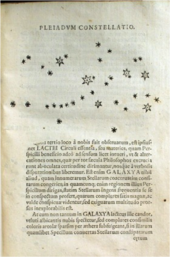
Galileo's drawings of the Pleiades star cluster from
Sidereus NunciusThe earliest-known depiction of the Pleiades is likely a Northern German Bronze Age artifact known as the Nebra sky disk, dated to approximately 1600 BC.[26] The Babylonian star catalogues name the Pleiades MULMUL(𒀯𒀯), meaning "stars" (literally "star star"), and they head the list of stars along the ecliptic, reflecting the fact that they were close to the point of vernal equinox around the 23rd century BC. The Ancient Egyptians may have used the names "Followers" and "Ennead" in the prognosis texts of the Calendar of Lucky and Unlucky Days of papyrus Cairo 86637.[27] Some Greek astronomers considered them to be a distinct constellation, and they are mentioned by Hesiod's Works and Days,[28] Homer's Iliad and Odyssey,[29] and the Geoponica.[30] The Pleiades was the most well-known star among pre-Islamic Arabs and so often simply referred to as "the Star" (al Najm).[31]Some scholars of Islam suggested that the Pleiades (ath-thurayya) are the "star" mentioned in Surah An-Najm("The Star") in the Quran.[32]
In Japan, the cluster is mentioned under the name Mutsuraboshi ("six stars") in the 8th-century Kojiki.[33] The cluster is now known in Japan as Subaru.
It was chosen as the name of the Subaru Telescope which is the 8.2-meter (320 in) flagship telescope of the National Astronomical Observatory of Japan. It is located at the Mauna Kea Observatory on the island of Hawaii. It had the largest monolithic primary mirror in the world from its commissioning in 1998 until 2005.[34]
It was chosen as the brand name of Subaru automobiles to reflect the origins of the firm as the joining of five companies, and is depicted in the firm's six-star logo.[35]
Observational history[edit]
Galileo Galilei was the first astronomer to view the Pleiades through a telescope. He thereby discovered that the cluster contains many stars too dim to be seen with the naked eye. He published his observations, including a sketch of the Pleiades showing 36 stars, in his treatise Sidereus Nuncius in March 1610.
The Pleiades have long been known to be a physically related group of stars rather than any chance alignment. John Michell calculated in 1767 that the probability of a chance alignment of so many bright stars was only 1 in 500,000, and so surmised that the Pleiades and many other clusters of stars must be physically related.[36] When studies were first made of the stars' proper motions, it was found that they are all moving in the same direction across the sky, at the same rate, further demonstrating that they were related.
Charles Messier measured the position of the cluster and included it as M45 in his catalogue of comet-like objects, published in 1771. Along with the Orion Nebula and the Praesepe cluster, Messier's inclusion of the Pleiades has been noted as curious, as most of Messier's objects were much fainter and more easily confused with comets—something that seems scarcely possible for the Pleiades. One possibility is that Messier simply wanted to have a larger catalogue than his scientific rival Lacaille, whose 1755 catalogue contained 42 objects, and so he added some bright, well-known objects to boost his list.[37]
Edme-Sébastien Jeaurat then drew in 1782 a map of 64 stars of the Pleiades from his observations in 1779, which he published in 1786.[38][39][40]
Distance[edit]
Location of Pleiades (circled) in the
night skyThe distance to the Pleiades can be used as a key first step to calibrate the cosmic distance ladder. As the cluster is relatively close to the Earth, its distance should be relatively easy to measure and has been estimated by many methods. Accurate knowledge of the distance allows astronomers to plot a Hertzsprung–Russell diagram for the cluster, which, when compared to those plotted for clusters whose distance is not known, allows their distances to be estimated. Other methods can then extend the distance scale from open clusters to galaxies and clusters of galaxies, and a cosmic distance ladder can be constructed. Ultimately astronomers' understanding of the age and future evolution of the universe is influenced by their knowledge of the distance to the Pleiades. Yet some authors argue that the controversy over the distance to the Pleiades discussed below is a red herring, since the cosmic distance ladder can (presently) rely on a suite of other nearby clusters where consensus exists regarding the distances as established by the Hipparcos satellite and independent means (e.g., the Hyades, Coma Berenices cluster, etc.).[3]
Measurements of the distance have elicited much controversy. Results prior to the launch of the Hipparcos satellite generally found that the Pleiades were about 135 parsecs (pc) away from Earth. Data from Hipparcos yielded a surprising result, namely a distance of only 118 pc by measuring the parallax of stars in the cluster—a technique that should yield the most direct and accurate results. Later work consistently argued that the Hipparcos distance measurement for the Pleiades was erroneous.[3][4][5][41][42][43] In particular, distances derived to the cluster via the Hubble Space Telescope and infrared color-magnitude diagram fitting (so-called "spectroscopic parallax") favor a distance between 135 and 140 pc;[3][41] a dynamical distance from optical interferometric observations of the Pleiad double Atlas favors a distance of 133 to 137 pc.[43] However, the author of the 2007–2009 catalog of revised Hipparcosparallaxes reasserted that the distance to the Pleiades is ~120 pc and challenged the dissenting evidence.[2] In 2012, Francis and Anderson[44] proposed that a systematic effect on Hipparcos parallax errors for stars in clusters biases calculation using the weighted mean and gave a Hipparcos parallax distance of 126 pc and photometric distance 132 pc based on stars in the AB Doradus, Tucana-Horologium, and Beta Pictoris moving groups, which are all similar in age and composition to the Pleiades. Those authors note that the difference between these results can be attributed to random error. More recent results using very-long-baseline interferometry (VLBI) (August 2014) and preliminary solutions using Gaia Data Release 1 (September 2016) and Gaia Data Release 2 (August 2018), determine distances of 136.2 ± 1.2 pc,[45] 134 ± 6 pc[46] and 136.2 ± 5.0 pc,[47] respectively. The Gaia Data Release 1 team was cautious about their result and the VLBI authors assert "that the Hipparcos-measured distance to the Pleiades cluster is in error".
For another distance debate see Polaris#Distance, also with a different measurement from Hipparcos, although this time it suggested a greater distance.
Composition[edit]
The cluster core radius is about 8 light-years and tidal radius is about 43 light-years. The cluster contains over 1,000 statistically confirmed members, a figure that excludes an unresolved likely further number of binary stars.[49] Its light is dominated by young, hot blue stars, up to 14 of which can be seen with the naked eye depending on local observing conditions and visual acuity of the observer. The arrangement of the brightest stars is somewhat similar to Ursa Major and Ursa Minor. The total mass contained in the cluster is estimated to be about 800 solar masses and is dominated by fainter and redder stars.[49] An estimate of the frequency of binary stars in the Pleiades is about 57%.[50]
The cluster contains many brown dwarfs, which are objects with less than about 8% of the Sun's mass, not heavy enough for nuclear fusion reactions to start in their cores and become proper stars. They may constitute up to 25% of the total population of the cluster, although they contribute less than 2% of the total mass.[51] Astronomers have made great efforts to find and analyse brown dwarfs in the Pleiades and other young clusters, because they are still relatively bright and observable, while brown dwarfs in older clusters have faded and are much more difficult to study.
Brightest stars[edit]
The nine brightest stars of the Pleiades are named for the Seven Sisters of Greek mythology: Sterope, Merope, Electra, Maia, Taygeta, Celaeno, and Alcyone, along with their parents Atlas and Pleione. As daughters of Atlas, the Hyades were sisters of the Pleiades. The following table gives details of the brightest stars in the cluster:
Age and future evolution[edit]
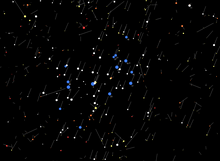
Stars of Pleiades with color and 10,000-year backwards proper motion shown
Ages for star clusters can be estimated by comparing the Hertzsprung–Russell diagram for the cluster with theoretical models of stellar evolution. Using this technique, ages for the Pleiades of between 75 and 150 million years have been estimated. The wide spread in estimated ages is a result of uncertainties in stellar evolution models, which include factors such as convective overshoot, in which a convective zone within a star penetrates an otherwise non-convective zone, resulting in higher apparent ages.
Another way of estimating the age of the cluster is by looking at the lowest-mass objects. In normal main-sequence stars, lithium is rapidly destroyed in nuclear fusion reactions. Brown dwarfs can retain their lithium, however. Due to lithium's very low ignition temperature of 2.5 × 106 K, the highest-mass brown dwarfs will burn it eventually, and so determining the highest mass of brown dwarfs still containing lithium in the cluster can give an idea of its age. Applying this technique to the Pleiades gives an age of about 115 million years.[53][54]
The cluster is slowly moving in the direction of the feet of what is currently the constellation of Orion. Like most open clusters, the Pleiades will not stay gravitationally bound forever. Some component stars will be ejected after close encounters with other stars; others will be stripped by tidal gravitational fields. Calculations suggest that the cluster will take about 250 million years to disperse, with gravitational interactions with giant molecular clouds and the spiral arms of our galaxy also hastening its demise.[55]
Reflection nebulosity[edit]
With larger amateur telescopes, the nebulosity around some of the stars can be easily seen; especially when long-exposure photographs are taken. Under ideal observing conditions, some hint of nebulosity around the cluster may even be seen with small telescopes or average binoculars. It is a reflection nebula, caused by dust reflecting the blue light of the hot, young stars.
It was formerly thought that the dust was left over from the formation of the cluster, but at the age of about 100 million years generally accepted for the cluster, almost all the dust originally present would have been dispersed by radiation pressure. Instead, it seems that the cluster is simply passing through a particularly dusty region of the interstellar medium.
Studies show that the dust responsible for the nebulosity is not uniformly distributed, but is concentrated mainly in two layers along the line of sight to the cluster. These layers may have been formed by deceleration due to radiation pressure as the dust has moved towards the stars.[56]
Possible planets[edit]
Analyzing deep-infrared images obtained by the Spitzer Space Telescope and Gemini North telescope, astronomers discovered that one of the cluster's stars, HD 23514, which has a mass and luminosity a bit greater than that of the Sun, is surrounded by an extraordinary number of hot dust particles. This could be evidence for planet formation around HD 23514.[57]
Gallery[edit]
A starchart of the Pleiades and their nebulae
Orion is a prominent constellation located on the celestial equator and visible throughout the world. It is one of the most conspicuous[1] and recognizable constellations in the night sky.[2] It is named after Orion, a hunter in Greek mythology. Its brightest stars are the blue-white Rigel (Beta Orionis) and the red Betelgeuse (Alpha Orionis).
Characteristics

The constellation of Orion, as it can be seen by the naked eye. Lines have been drawn.
Orion is bordered by Taurus to the northwest, Eridanus to the southwest, Lepus to the south, Monoceros to the east, and Gemini to the northeast. Covering 594 square degrees, Orion ranks twenty-sixth of the 88 constellations in size. The constellation boundaries, as set by Belgian astronomer Eugène Delporte in 1930, are defined by a polygon of 26 sides. In the equatorial coordinate system, the right ascension coordinates of these borders lie between 04h 43.3mand 06h 25.5m , while the declination coordinates are between 22.87° and −10.97°.[3] The constellation's three-letter abbreviation, as adopted by the International Astronomical Union in 1922, is "Ori".[4]
Orion is most visible in the evening sky from January to April,[5]winter in the Northern Hemisphere, and summer in the Southern Hemisphere. In the tropics (less than about 8° from the equator), the constellation transits at the zenith.
In the period May–July (summer in the Northern Hemisphere, winter in the Southern Hemisphere), Orion is in the daytime sky and thus invisible at most latitudes. However, for much of Antarctica in the Southern Hemisphere's winter months, the Sun is below the horizon even at midday. Stars (and thus Orion, but only the brightest stars) are then visible at twilight for a few hours around local noon, just in the brightest section of the sky low in the North where the Sun is just below the horizon. At the same time of day at the South Pole itself (Amundsen–Scott South Pole Station), Rigel is only 8° above the horizon, and the Belt sweeps just along it. In the Southern Hemisphere's summer months, when Orion is normally visible in the night sky, the constellation is actually not visible in Antarctica because the sun does not set at that time of year south of the Antarctic Circle.[6][7]
In countries close to the equator (e.g., Kenya, Indonesia, Colombia, Ecuador), Orion appears overhead in December around midnight and in the February evening sky.
Navigational aid
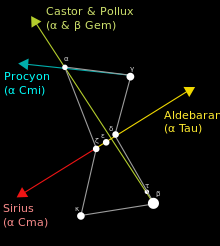
Using Orion to find stars in neighbor constellations
Orion is very useful as an aid to locating other stars. By extending the line of the Belt southeastward, Sirius (α CMa) can be found; northwestward, Aldebaran (α Tau). A line eastward across the two shoulders indicates the direction of Procyon (α CMi). A line from Rigel through Betelgeuse points to Castor and Pollux (α Gem and β Gem). Additionally, Rigel is part of the Winter Circle asterism. Sirius and Procyon, which may be located from Orion by following imaginary lines (see map), also are points in both the Winter Triangleand the Circle.
Features

Orion as depicted in
Urania's Mirror, a set of constellation cards published in London c.1825
Orion's seven brightest stars form a distinctive hourglass-shaped asterism, or pattern, in the night sky. Four stars—Rigel, Betelgeuse, Bellatrix, and Saiph—form a large roughly rectangular shape, at the center of which lies the three stars of Orion's Belt—Alnitak, Alnilam, and Mintaka. Descending from the "belt" is a smaller line of three stars, Orion's Sword (the middle of which is in fact not a star but the Orion Nebula), also known as the hunter's sword.
Many of the stars are luminous hot blue supergiants, with the stars of the belt and sword forming the Orion OB1 association. Standing out by its red hue, Betelgeuse may nevertheless be a runaway member of the same group.
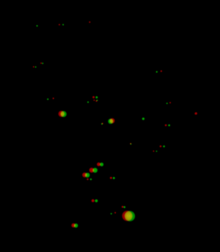
Stars of the constellation by distance (red-green 3D view) and the brightness of each star (star size)
Bright stars
- Betelgeuse, also designated Alpha Orionis, is a massive M-type red supergiant star nearing the end of its life. It is the second brightest star in Orion, and is a semiregular variable star.[9] It serves as the "right shoulder" of the hunter it represents (assuming that he is facing the observer). It is generally the eleventh brightest star in the night sky, but this has varied between being the tenth brightest to the 23rd brightest by the end of 2019.[10][11] The end of its life is expected to result in a supernova explosion that will be highly visible from Earth, possibly outshining the Earth's moon and being visible during the day. This is most likely to occur within the next 100,000 years.[12]
- Rigel, also known as Beta Orionis, is a B-type blue supergiant that is the sixth brightest star in the night sky. Similar to Betelgeuse, Rigel is fusing heavy elements in its core and will pass its supergiant stage soon (on an astronomical timescale), either collapsing in the case of a supernova or shedding its outer layers and turning into a white dwarf. It serves as the left foot of Orion, the hunter.[13]
- Bellatrix is designated Gamma Orionis by Johann Bayer. It is the twenty-seventh brightest star in the night sky. Bellatrix is considered a B-type blue giant, though it is too small to explode in a supernova. Bellatrix's luminosity is derived from its high temperature rather than a large radius.[14] Bellatrix marks Orion's left shoulder and it means the "female warrior", and is sometimes known colloquially as the "Amazon Star".[15] It is the closest major star in Orion at only 244.6 light years.
- Mintaka is designated Delta Orionis, despite being the faintest of the three stars in Orion's Belt. Its name means "the belt". It is a multiple star system, composed of a large B-type blue giant and a more massive O-type main-sequence star. The Mintaka system constitutes an eclipsing binary variable star, where the eclipse of one star over the other creates a dip in brightness. Mintaka is the westernmost of the three stars of Orion's Belt, as well as the northernmost.
- Alnilam is designated Epsilon Orionis and is named for the Arabic phrase meaning "string of pearls". It is the middle and brightest of the three stars of Orion's Belt. Alnilam is a B-type blue supergiant; despite being nearly twice as far from the Sun as the other two belt stars, its luminosity makes it nearly equal in magnitude. Alnilam is losing mass quickly, a consequence of its size. It is the farthest major star in Orion at approximately 2,000 light years.
- Alnitak, meaning "the girdle", is designated Zeta Orionis, and is the easternmost star in Orion's Belt. It is a triple star system, with the primary star being a hot blue supergiant and the brightest class O star in the night sky.
- Saiph is designated Kappa Orionis by Bayer, and serves as Orion's right foot. It is of a similar distance and size to Rigel, but appears much fainter. It means the "sword of the giant"
- Meissa is designated Lambda Orionis, forms Orion's head, and is a multiple star with a combined apparent magnitude of 3.33. Its name means the "shining one".
Belt
Orion's Belt or The Belt of Orion is an asterism within the constellation. It consists of the three bright stars Zeta (Alnitak), Epsilon (Alnilam), and Delta(Mintaka). Alnitak is around 800 light years away from earth and is 100,000 times more luminous than the Sun and shines with magnitude 1.8; much of its radiation is in the ultraviolet range, which the human eye cannot see.[16] Alnilam is approximately 2,000 light years away from Earth, shines with magnitude 1.70, and with ultraviolet light is 375,000 times more luminous than the Sun.[17] Mintaka is 915 light years away and shines with magnitude 2.21. It is 90,000 times more luminous than the Sun and is a double star: the two orbit each other every 5.73 days.[18] In the Northern Hemisphere, Orion's Belt is best visible in the night sky during the month of January around 9:00 pm, when it is approximately around the local meridian.[2]
Just southwest of Alnitak lies Sigma Orionis, a multiple star system composed of five stars that have a combined apparent magnitude of 3.7 and lying 1150 light years distant. Southwest of Mintaka lies the quadruple star Eta Orionis.
Sword
Orion's Sword contains the Orion Nebula, the Messier 43 nebula, the Running Man Nebula, and the stars Theta Orionis, Iota Orionis, and 42 Orionis.
Head
Three stars comprise a small triangle that marks the head. The apex is marked by Meissa (Lambda Orionis), a hot blue giant of spectral type O8 III and apparent magnitude 3.54, which lies some 1100 light years distant. Phi-1 and Phi-2 Orionis make up the base. Also nearby is the very young star FU Orionis.
Club
Stretching north from Betelgeuse are the stars that make up Orion's club. Mu Orionis marks the elbow, Nu and Xi mark the handle of the club, and Chi1and Chi2 mark the end of the club. Just east of Chi1 is the Mira-type variable red giant U Orionis.
Shield
West from Bellatrix lie six stars all designated Pi Orionis (π1 Ori, π2 Ori, π3 Ori, π4 Ori, π5 Ori and π6 Ori) which make up Orion's shield.
Meteor showers
Around 20 October each year the Orionid meteor shower (Orionids) reaches its peak. Coming from the border with the constellation Gemini as many as 20 meteors per hour can be seen. The shower's parent body is Halley's Comet.[19]
Deep-sky objects
Hanging from Orion's belt is his sword, consisting of the multiple stars θ1 and θ2 Orionis, called the Trapezium and the Orion Nebula (M42). This is a spectacular object that can be clearly identified with the naked eye as something other than a star. Using binoculars, its clouds of nascent stars, luminous gas, and dust can be observed. The Trapezium cluster has many newborn stars, including several brown dwarfs, all of which are at an approximate distance of 1,500 light-years. Named for the four bright stars that form a trapezoid, it is largely illuminated by the brightest stars, which are only a few hundred thousand years old. Observations by the Chandra X-ray Observatory show both the extreme temperatures of the main stars—up to 60,000 kelvins—and the star forming regions still extant in the surrounding nebula.[20]
M78 (NGC 2068) is a nebula in Orion. With an overall magnitude of 8.0, it is significantly dimmer than the Great Orion Nebula that lies to its south; however, it is at approximately the same distance, at 1600 light-years from Earth. It can easily be mistaken for a comet in the eyepiece of a telescope. M78 is associated with the variable star V351 Orionis, whose magnitude changes are visible in very short periods of time. Another fairly bright nebula in Orion is NGC 1999, also close to the Great Orion Nebula. It has an integrated magnitude of 10.5 and is 1500 light-years from Earth. The variable star V380 Orionis is embedded in NGC 1999.
Another famous nebula is IC 434, the Horsehead Nebula, near ζ Orionis. It contains a dark dust cloud whose shape gives the nebula its name.
NGC 2174 is an emission nebula located 6400 light-years from Earth.
Besides these nebulae, surveying Orion with a small telescope will reveal a wealth of interesting deep-sky objects, including M43, M78, as well as multiple stars including Iota Orionis and Sigma Orionis. A larger telescope may reveal objects such as the Flame Nebula (NGC 2024), as well as fainter and tighter multiple stars and nebulae. Barnard's Loop can be seen on very dark nights or using long-exposure photography.
All of these nebulae are part of the larger Orion molecular cloud complex, which is located approximately 1,500 light-years away and is hundreds of light-years across. It is one of the most intense regions of stellar formation visible within our galaxy.
History and mythology
The earliest known depiction linked to the constellation of Orion is a prehistoric (Aurignacian) mammoth ivory carving found in a cave in the Ach valley in West Germany in 1979. Archaeologists estimate that it is 32,000 to 38,000 years old.[23][24][25] The distinctive pattern of Orion is recognized in numerous cultures around the world, and many myths are associated with it. Orion is used as a symbol in the modern world.
Ancient Near East

Orion (constellation) Art
The Babylonian star catalogues of the Late Bronze Age name Orion MULSIPA.ZI.AN.NA,[note 1] "The Heavenly Shepherd" or "True Shepherd of Anu" – Anu being the chief god of the heavenly realms.[26] The Babylonian constellation is sacred to Papshukal and Ninshubur, both minor gods fulfilling the role of 'messenger to the gods'. Papshukal is closely associated with the figure of a walking bird on Babylonian boundary stones, and on the star map the figure of the Rooster is located below and behind the figure of the True Shepherd—both constellations represent the herald of the gods, in his bird and human forms respectively.[27]
In ancient Egypt, the stars of Orion were regarded as a god, called Sah. Because Orion rises before Sirius, the star whose heliacal rising was the basis for the Solar Egyptian calendar, Sah was closely linked with Sopdet, the goddess who personified Sirius. The god Sopdu is said to be the son of Sah and Sopdet. Sah is syncretized with Osiris, while Sopdet is syncretized with Osiris' mythological wife, Isis. In the Pyramid Texts, from the 24th and 23rd centuries BC, Sah is one of many gods whose form the dead pharaoh is said to take in the afterlife.[28]
The Armenians identified their legendary patriarch and founder Hayk with Orion. Hayk is also the name of the Orion constellation in the Armenian translation of the Bible.[29]
The Bible mentions Orion three times, naming it "Kesil" (כסיל, literally – fool). Though, this name perhaps is etymologically connected with "Kislev", the name for the ninth month of the Hebrew calendar (i.e. November–December), which, in turn, may derive from the Hebrew root K-S-L as in the words "kesel, kisla" (כֵּסֶל, כִּסְלָה, hope, positiveness), i.e. hope for winter rains.: Job 9:9 ("He is the maker of the Bear and Orion"), Job 38:31 ("Can you loosen Orion's belt?"), and Amos 5:8 ("He who made the Pleiades and Orion").
In ancient Aram, the constellation was known as Nephîlā′, the Nephilim are said to be Orion's descendants.[30]
Greco-Roman antiquity
In Greek mythology, Orion was a gigantic, supernaturally strong hunter,[31] born to Euryale, a Gorgon, and Poseidon (Neptune), god of the sea. One myth recounts Gaia's rage at Orion, who dared to say that he would kill every animal on Earth. The angry goddess tried to dispatch Orion with a scorpion. This is given as the reason that the constellations of Scorpius and Orion are never in the sky at the same time. However, Ophiuchus, the Serpent Bearer, revived Orion with an antidote. This is said to be the reason that the constellation of Ophiuchus stands midway between the Scorpion and the Hunter in the sky.
The constellation is mentioned in Horace's Odes (Ode 3.27.18), Homer's Odyssey (Book 5, line 283) and Iliad, and Virgil's Aeneid (Book 1, line 535)
Middle East
In medieval Muslim astronomy, Orion was known as al-jabbar, "the giant".[33] Orion's sixth brightest star, Saiph, is named from the Arabic, saif al-jabbar, meaning "sword of the giant".[34]
China
In China, Orion was one of the 28 lunar mansions Sieu (Xiù) (宿). It is known as Shen (參), literally meaning "three", for the stars of Orion's Belt. (See Chinese constellations)
The Chinese character 參 (pinyin shēn) originally meant the constellation Orion (Chinese: 參宿; pinyin: shēnxiù); its Shang dynasty version, over three millennia old, contains at the top a representation of the three stars of Orion's belt atop a man's head (the bottom portion representing the sound of the word was added later).[35]
India

Orion Constellation photographed from Karad, India
The Rigveda refers to the Orion Constellation as Mriga (The Deer).[36]
Nataraja, 'the cosmic dancer', is often interpreted as the representation of Orion. Rudra, the Rigvedic form of Shiva, is the presiding deity of Ardra nakshatra (Betelgeuse) of Hindu astrology.[37]
The Jain Symbol carved in Udayagiri and Khandagiri Caves, India in 1st century BCE[38] has striking resemblance with Orion.
Bugis sailors identified the three stars in Orion's Belt as tanra tellué, meaning "sign of three".[39]
European folklore
In old Hungarian tradition, "Orion" is known as (magic) Archer (Íjász), or Reaper (Kaszás). In recently rediscovered myths, he is called Nimrod (Hungarian "Nimród"), the greatest hunter, father of the twins "Hunor" and "Magor". The "π" and "o" stars (on upper right) form together the reflex bow or the lifted scythe. In other Hungarian traditions, "Orion's belt" is known as "Judge's stick" (Bírópálca).[40]
In Scandinavian tradition, "Orion's belt" was known as Frigg's Distaff (friggerock) or Freyja's distaff.[41]
The Finns call Orion's belt and the stars below it Väinämöisen viikate (Väinämöinen's scythe).[42] Another name for the asterism of Alnilam, Alnitak and Mintaka is Väinämöisen vyö (Väinämöinen's Belt) and the stars "hanging" from the belt as Kalevanmiekka (Kaleva's sword).
In Siberia, the Chukchi people see Orion as a hunter; an arrow he has shot is represented by Aldebaran (Alpha Tauri), with the same figure as other Western depictions.
Americas
The Seri people of northwestern Mexico call the three stars in the belt of Orion Hapj (a name denoting a hunter) which consists of three stars: Hap (mule deer), Haamoja (pronghorn), and Mojet (bighorn sheep). Hap is in the middle and has been shot by the hunter; its blood has dripped onto Tiburón Island.[44]
The same three stars are known in Spain and most of Latin America as "Las tres Marías" (Spanish for "The Three Marys"). In Puerto Rico, the three stars are known as the "Los Tres Reyes Magos" (Spanish for The three Wise Men).[45]
The Ojibwa (Chippewa) Native Americans call this constellation Kabibona'kan, the Winter Maker, as its presence in the night sky heralds winter.[citation needed]
To the Lakota Native Americans, Tayamnicankhu (Orion's Belt) is the spine of a bison. The great rectangle of Orion is the bison's ribs; the Pleiades star cluster in nearby Taurus is the bison's head; and Sirius in Canis Major, known as Tayamnisinte, is its tail. Another Lakota myth mentions that the bottom half of Orion, the Constellation of the Hand, represented the arm of a chief that was ripped off by the Thunder People as a punishment from the gods for his selfishness. His daughter offered to marry the person who can retrieve his arm from the sky, so the young warrior Fallen Star (whose father was a star and whose mother was human) returned his arm and married his daughter, symbolizing harmony between the gods and humanity with the help of the younger generation. The index finger is represented by Rigel; the Orion Nebula is the thumb; the Belt of Orion is the wrist; and the star Beta Eridani is the pinky finger.[46]
Austronesian
The seven primary stars of Orion make up the Polynesian constellation Heiheionakeiki which represents a child's string figure similar to a cat's cradle. Precolonial Visayans referred to it as "balatik" (ballista) as it resembles a trap of the same name which fires arrows by itself and is usually used for catching pigs from the bush.[47][48]
In Māori tradition, the star Rigel (known as Puanga or Puaka) is closely connected with the celebration of Matariki. The rising of Matariki (the Pleiades) and Rigel before sunrise in midwinter marks the start of the Māori year.[49]
Contemporary symbolism
The imagery of the belt and sword has found its way into popular western culture, for example in the form of the shoulder insignia of the 27th Infantry Division of the United States Army during both World Wars, probably owing to a pun on the name of the division's first commander, Major General John F. O'Ryan.[50][51]
The film distribution company Orion Pictures used the constellation as its logo.[52]
Depictions
In artistic renderings, the surrounding constellations are sometimes related to Orion: he is depicted standing next to the river Eridanus with his two hunting dogs Canis Major and Canis Minor, fighting Taurus. He is sometimes depicted hunting Lepus the hare. He sometimes is depicted to have a lion's hide in his hand.
There are alternative ways to visualise Orion. From the Southern Hemisphere, Orion is oriented south-upward, and the belt and sword are sometimes called the saucepan or pot in Australia and New Zealand. Orion's Belt is called Drie Konings (Three Kings) or the Drie Susters (Three Sisters) by Afrikaans speakers in South Africa[53] and are referred to as les Trois Rois (the Three Kings) in Daudet's Lettres de Mon Moulin (1866). The appellation Driekoningen (the Three Kings) is also often found in 17th- and 18th-century Dutch star charts and seaman's guides. The same three stars are known in Spain, Latin America, and the Philippines as "Las Tres Marías" (The Three Marys), and as "Los Tres Reyes Magos" (The three Wise Men) in Puerto Rico.[45]
Even traditional depictions of Orion have varied greatly. Cicero drew Orion in a similar fashion to the modern depiction. The Hunter held an unidentified animal skin aloft in his right hand; his hand was represented by Omicron2 Orionis and the skin was represented by the 5 stars designated Pi Orionis. Kappa and Beta Orionis represented his left and right knees, while Eta and Lambda Leporis were his left and right feet, respectively. As in the modern depiction, Delta, Epsilon, and Zeta represented his belt. His left shoulder was represented by Alpha Orionis, and Mu Orionis made up his left arm. Lambda Orionis was his head and Gamma, his right shoulder. The depiction of Hyginus was similar to that of Cicero, though the two differed in a few important areas. Cicero's animal skin became Hyginus's shield (Omicron and Pi Orionis), and instead of an arm marked out by Mu Orionis, he holds a club (Chi Orionis). His right leg is represented by Theta Orionis and his left leg is represented by Lambda, Mu, and Epsilon Leporis. Further Western European and Arabic depictions have followed these two models.
Future
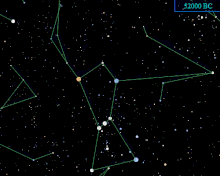
Animation showing Orion's proper motion from 50000 BC to 50000 AD. Pi3 Orionis moves the most rapidly.
Orion is located on the celestial equator, but it will not always be so located due to the effects of precession of the Earth's axis. Orion lies well south of the ecliptic, and it only happens to lie on the celestial equator because the point on the ecliptic that corresponds to the June solstice is close to the border of Gemini and Taurus, to the north of Orion. Precession will eventually carry Orion further south, and by AD 14000, Orion will be far enough south that it will no longer be visible from the latitude of Great Britain.[54]
Further in the future, Orion's stars will gradually move away from the constellation due to proper motion. However, Orion's brightest stars all lie at a large distance from the Earth on an astronomical scale—much farther away than Sirius, for example. Orion will still be recognizable long after most of the other constellations—composed of relatively nearby stars—have distorted into new configurations, with the exception of a few of its stars eventually exploding as supernovae, for example Betelgeuse, which is predicted to explode sometime in the next million years.[55]
My book: The Holy Bible, Contains the Old and New Testament, NKJV, New King James Version, Thomas Nelson Bibles, A Division of Thomas Nelson, Inc., Copyright 1982 by Thomas Nelson, Inc.: Inscription, January 10, 2008: “Just love and day enduring”.
